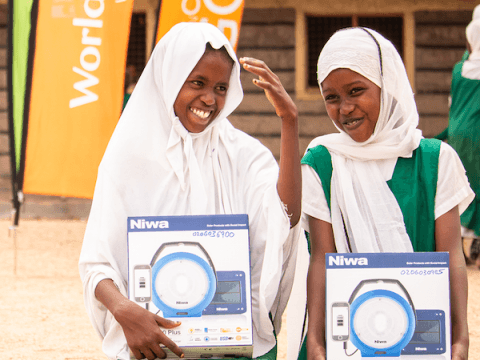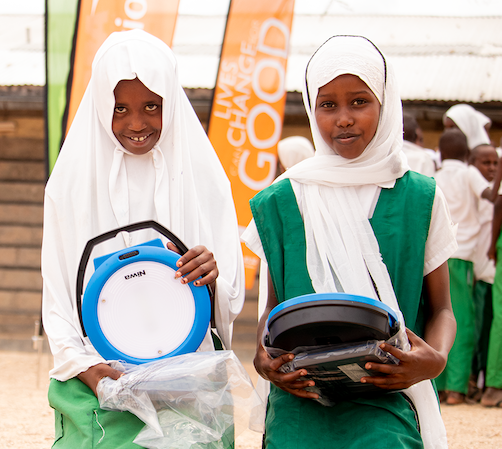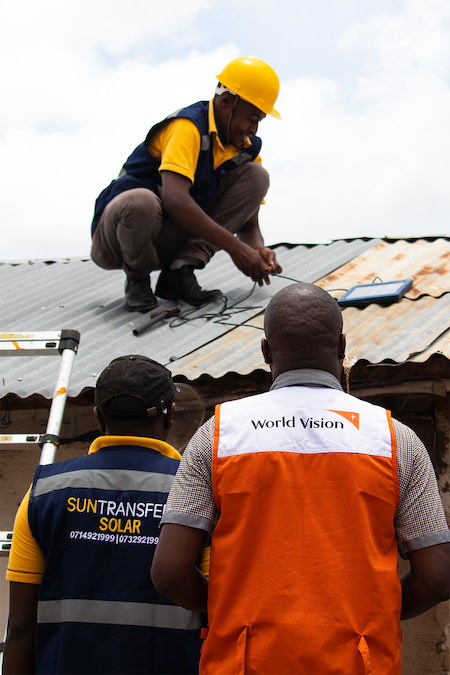Solar Power Lights Rural Communities and Boosts School Performance

By Wesley Koskei, World Vision Communications Department, Kenya
Nine-year-old old Zainab smiles shyly as she repeatedly turns the knob of a brand new lantern left and right, so as to switch the lamp’s light on and off.
Her friend Kule, seated next to Zainab under the shade of an acacia tree, is equally joyful. She laughs heartily while pulling a lantern that she has also received out of a box.
“Today I go home with a light,” says nine-year old Kule with so much excitement.

The two are Grade Three pupils of Dida Abakiri Primary School, situated in the Barimbate area of Kenya’s Isiolo County.
They are among the 150 children at the institution that have received solar lanterns through a 10 million Kenya shillings solar project dubbed ‘One Light Per Child.’
World Vision supports the initiative in partnership with Suntransfer, through the Integrated Management of Natural Resources for Resilience in Arid and Semi-Arid Lands (IMARA) programme in Kenya, which is funded by the Swedish International Development Co-operation Agency (SIDA).
“In the marginalised communities, access to quality education is limited. But tonight, these children will read and do their homework using the lanterns. This will eventually better their education,” said Obadiah Kisang, the Director of the IMARA programme for World Vision in Kenya.
The lanterns are therefore helping to bridge the school performance gap between children from poor backgrounds that lack electricity and those from affluent families that can afford it.

Without access to affordable and quality light sources, children are usually unable to engage in further studies or revision while at home in the evenings.
In addition, teachers in boarding schools offering evening classes cannot teach children without light when darkness sets in. This denies pupils the opportunity to enhance their literacy skill through continuous learning.
The solar project is also a key contributor to of the Sustainable Development Goals (SDGs) ‘7’ aimed at enhancing access to affordable and clean energy for all people.
“We are supplying these solar products to enhance access to clean energy lighting solutions among communities in need of them. We would like to create solar villages in rural Kenya,” Dominic Wanyoike, a clean energy expert for Suntransfer in Kenya said.
Research conducted by the company in parts of Isiolo County (Kula Mawe and Barimbate) revealed that families spend nearly 25 percent of their household income on costly, low-quality sources of energy such as fuel wood, charcoal, car and dry cell batteries.
The solar lanterns are therefore addressing the challenge by providing an alternative energy source that is safe and environmentally friendly.

As solar products use free energy from the sun, families no longer have to incur fuel costs that previously drained their scarce financial resources.
“Today we will light our world! Usually, we have one torch in this house and whenever I go to the kitchen with it to cook, the kids and their father remain in the dark in the sitting room,” says Nuria, a mother of seven children whose family was among the 720 that benefited from solar panels, lampshades, lanterns and cables in Kula Mawe and Barimbate locations of Isiolo County.